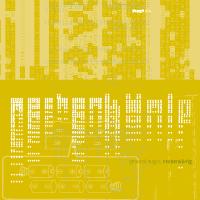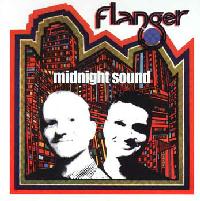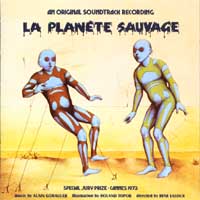- Administrator
- Albums and Singles
 After a four-year hiatus,Mego favorites General Magic return with Rechenkoenig, a brilliantfollow-up to their debut album, Frantz. Ramon Bauer and Andreas Pieper,who comprise General Magic, have a reputation of steering clear of theconventions to which minimal electronic music is often prone. Thetracks on Rechenkoenig are brief in length, and juxtaposed with suchsonic abruptness that the listener is kept constantly on edge, withoutpossibility of repetition-induced boredom. In fact, 'minimal' isprobably the adjective furthest from my mind upon hearing the fragmentsof frantically paced beats, often heavily distorted, scattered amongstdigital twittering, crackling, and outright onslaughts of noise.
After a four-year hiatus,Mego favorites General Magic return with Rechenkoenig, a brilliantfollow-up to their debut album, Frantz. Ramon Bauer and Andreas Pieper,who comprise General Magic, have a reputation of steering clear of theconventions to which minimal electronic music is often prone. Thetracks on Rechenkoenig are brief in length, and juxtaposed with suchsonic abruptness that the listener is kept constantly on edge, withoutpossibility of repetition-induced boredom. In fact, 'minimal' isprobably the adjective furthest from my mind upon hearing the fragmentsof frantically paced beats, often heavily distorted, scattered amongstdigital twittering, crackling, and outright onslaughts of noise.samples:
Read More
- Administrator
- Albums and Singles
 Tino Corp has releasedthis special 12" EP to celebrate the 10th anniversary of the release ofone of the most important techno releases of the 90s. But why???Truthfully there's really only a couple decent mixes on this record,but none of them are varied even remotely enough as the originalrelease. This doesn't make up for the original House of God (HolophonicSound EP) which was stolen from me, which I can no longer replace. Outof the four mixes, the DHS mix might be my favorite, newer samples giveit a more modern feel, but in all honesty, to me it's rather lukewarmcompared to the trancey, hypnotic original. At first, I'm tempted toguess that the tracklisting on side 2 is incorrect as track 1 soundsmore like a MBM remix with some of the various sounds. However, withfurther listening, those samples used sure seem to yank a ton from MBMback catalogue. Could this be a form of hero worship? MBM'sconrtibution probes more of the deep trancey sounds, without jumpinginto MBM-esque breakbeat we're more familiar with hearing. Well, thanksfor teasing us with this release, but the original EP should truly bemade available again.
Tino Corp has releasedthis special 12" EP to celebrate the 10th anniversary of the release ofone of the most important techno releases of the 90s. But why???Truthfully there's really only a couple decent mixes on this record,but none of them are varied even remotely enough as the originalrelease. This doesn't make up for the original House of God (HolophonicSound EP) which was stolen from me, which I can no longer replace. Outof the four mixes, the DHS mix might be my favorite, newer samples giveit a more modern feel, but in all honesty, to me it's rather lukewarmcompared to the trancey, hypnotic original. At first, I'm tempted toguess that the tracklisting on side 2 is incorrect as track 1 soundsmore like a MBM remix with some of the various sounds. However, withfurther listening, those samples used sure seem to yank a ton from MBMback catalogue. Could this be a form of hero worship? MBM'sconrtibution probes more of the deep trancey sounds, without jumpinginto MBM-esque breakbeat we're more familiar with hearing. Well, thanksfor teasing us with this release, but the original EP should truly bemade available again.samples:
Read More
- Administrator
- Albums and Singles
 Flanger is the prolificGerman duo of Bernd Friedmann (Burnt Friedman & The Nu Dub Players,Nonplace Urban Field, etc) and Uwe Schmidt (Atom Heart, Señor Coconut,etc). This is their 2nd album, follow-up to last year's "Templates",both on Ninja Tune's Ntone subdivision. "Midnight Sound" evolves beyondthe debut with a more humanized fusion of organic and electronic latinflavors and jazz sensibilities, very similar to Burnt Friedman's "ConRitmo". Most tracks are in the mid to high tempo range save for thealbum's bookends. "Nightbeat 1" and "Stepping Out of My Dream" bothoffer up slow brushed snare smokiness, the latter an especiallycompelling 7+ minute piece of sonic mood art that alone is worth theprice of entry for the disc. A vibe heavy, horn free interpretation ofthe Miles Davis classic "So What" is a respectfully well done treat.The rest are faster paced, chock full of all sorts of rapid-fire bass,vibe, organ and key lines and programmed pseudo-drum 'n bass beatsaugmented by Friednman's additional percussion flair. Several songsslowly dissolve at times to reveal the electro-glitch and micro-beatunderbellies beneath the bossa nova. "Midnight Sound" is simplysublime. This and "Con Ritmo" can fill your crossbred future-jazzneeds for a while.
Flanger is the prolificGerman duo of Bernd Friedmann (Burnt Friedman & The Nu Dub Players,Nonplace Urban Field, etc) and Uwe Schmidt (Atom Heart, Señor Coconut,etc). This is their 2nd album, follow-up to last year's "Templates",both on Ninja Tune's Ntone subdivision. "Midnight Sound" evolves beyondthe debut with a more humanized fusion of organic and electronic latinflavors and jazz sensibilities, very similar to Burnt Friedman's "ConRitmo". Most tracks are in the mid to high tempo range save for thealbum's bookends. "Nightbeat 1" and "Stepping Out of My Dream" bothoffer up slow brushed snare smokiness, the latter an especiallycompelling 7+ minute piece of sonic mood art that alone is worth theprice of entry for the disc. A vibe heavy, horn free interpretation ofthe Miles Davis classic "So What" is a respectfully well done treat.The rest are faster paced, chock full of all sorts of rapid-fire bass,vibe, organ and key lines and programmed pseudo-drum 'n bass beatsaugmented by Friednman's additional percussion flair. Several songsslowly dissolve at times to reveal the electro-glitch and micro-beatunderbellies beneath the bossa nova. "Midnight Sound" is simplysublime. This and "Con Ritmo" can fill your crossbred future-jazzneeds for a while.samples:
Read More
- Administrator
- Albums and Singles
 The Montreal-based collective Molasses has released its second discthrough Alien8 Recordings' associated label, Fancy. Like the first one,the packaging is exquisite (a triple-gatefold sleeve with embossedwriting and stickers) and the music is limited to only a few songs(three if you don't count the untitled first track of church bells).Each song tears at the gut strings from a seemlingly tired heartbrokensoul from a cold, bleak and desolate area, north of the border.Molasses is led by singer/songwriter Scott Chernoff and featuresgodspeed members Thierry (bass) and Norsola (cello) as well as ShalabiEffect leader Sam Shalabi on guitar. This time around, the collectivesound has matured, with the production sounding far more professionalbut not losing that human feel. Included is a 14-minute version ofAmazing Grace, and while this old standard pops up almost seemingly toooften, the Molasses version contained herein fits in perfectly with therest of the disc.
The Montreal-based collective Molasses has released its second discthrough Alien8 Recordings' associated label, Fancy. Like the first one,the packaging is exquisite (a triple-gatefold sleeve with embossedwriting and stickers) and the music is limited to only a few songs(three if you don't count the untitled first track of church bells).Each song tears at the gut strings from a seemlingly tired heartbrokensoul from a cold, bleak and desolate area, north of the border.Molasses is led by singer/songwriter Scott Chernoff and featuresgodspeed members Thierry (bass) and Norsola (cello) as well as ShalabiEffect leader Sam Shalabi on guitar. This time around, the collectivesound has matured, with the production sounding far more professionalbut not losing that human feel. Included is a 14-minute version ofAmazing Grace, and while this old standard pops up almost seemingly toooften, the Molasses version contained herein fits in perfectly with therest of the disc.samples:
Read More
- Administrator
- Albums and Singles
 Known in English-speaking countries as 'Fantastic Planet,' the sountrack from this highly acclaimed cult-classic cartoon film from 1973 is finally available. For any fan of the film, this is a -must have- as the music is spectacularly anthemic and seemingly timeless. As I was browsing aorund the Twisted Village here in Cambridge, I saw the recently arrive disc sitting on the counter, priced up and ready to hit the shelves. My jaw dropped and I had to walk away with it. Minutes later in Other Music, the crew found it fit for in-store play and I was in heaven.
Known in English-speaking countries as 'Fantastic Planet,' the sountrack from this highly acclaimed cult-classic cartoon film from 1973 is finally available. For any fan of the film, this is a -must have- as the music is spectacularly anthemic and seemingly timeless. As I was browsing aorund the Twisted Village here in Cambridge, I saw the recently arrive disc sitting on the counter, priced up and ready to hit the shelves. My jaw dropped and I had to walk away with it. Minutes later in Other Music, the crew found it fit for in-store play and I was in heaven.
 
The music is a futuristic look which is dated by the early 70s, with a rich brass and string orchestra playing alongside various electronic guitars, analogue keyboards, drums and slappy bass. From the first few notes, chills run down my spine as I think back to when I watched this first on late night television at around 15 years old. Immediately the main themes are burned deep into my skull. The sound pulls me in like the pied piper led the mice and I end up whistling the themes all day long. My only complaint is that at 37 minutes, it's far too short.
 
samples:
Read More
- Administrator
- Albums and Singles
 Available once again (no clue if this one's limited) is one of my top-10 albums of the year. The Un-Releases was originally released earlier this year in an "official" bootleg teeny-tiny quantity which barely made it across the water to the USA. Now, through K in Olympia, Washington the disc should be easier to get a hold of.
Available once again (no clue if this one's limited) is one of my top-10 albums of the year. The Un-Releases was originally released earlier this year in an "official" bootleg teeny-tiny quantity which barely made it across the water to the USA. Now, through K in Olympia, Washington the disc should be easier to get a hold of.33 tracks grace the disc, with bits and pieces of studio madness and silly fun collected junk between the hit songs like "Glamour Girl," and "Euro Trash Girl." Also appearing are various cover tunes including two B-52s songs "Give Me Back My Man," and "Song for a Future Generation." Highlights of the disc however include three versions of "Mind Your Own Business" and the booming metal guitar-drenched opener "Turn of the Century" along with "Panasonic Rip-Off" (stolen from the Panasonic 12" single 'B', with Chicks vocals added.) Obnoxiously enough the tracklisting is buried inside the cardboard so the case has to be destroyed to read basically. Save yourself the destruction and consult the CDDB for a tracklist. Clever and entertaining, I will re-iterate that the world of electronica needs the Chicks on Speed like it needs V/Vm and Kid 606, so people can enjoy electronic music and have fun with it without being sleepy laptop fuckers. Look for the Chicks trying to get some US dates in the near future and don't miss their show.
samples:
Read More
- Administrator
- Albums and Singles
samples:
Read More
- Duncan Edwards
- Albums and Singles
 Thankfully, Oi! is not a trawl through a dubious underbelly of UK punk. It’s a two disc snapshot of recent Brazilian music from Amapa to Rio Grande Do Sul, Acre to Paraiba, mapping the places where indigenous forms meet dub, funk, psychedelia, and several other outer-national sub-genres. Of the 40 tracks I prefer those suggesting cool, dark alleys, mind warping neon surfboards, or vertigo-inducing rooftops, to others which feel like over-crowded hip-hop/carnival nether regions where “party” is a verb and Karl Pilkington dreams of quiet reverie during a hellish episode of An Idiot Abroad.
Thankfully, Oi! is not a trawl through a dubious underbelly of UK punk. It’s a two disc snapshot of recent Brazilian music from Amapa to Rio Grande Do Sul, Acre to Paraiba, mapping the places where indigenous forms meet dub, funk, psychedelia, and several other outer-national sub-genres. Of the 40 tracks I prefer those suggesting cool, dark alleys, mind warping neon surfboards, or vertigo-inducing rooftops, to others which feel like over-crowded hip-hop/carnival nether regions where “party” is a verb and Karl Pilkington dreams of quiet reverie during a hellish episode of An Idiot Abroad.
There is some fascinating cross pollination of styles to be heard on Oi! but it sometimes that is not enough. For example, while "Ovelhinhas" by Cidadao Instigado is intriguingly described as"schizophrenic brega" and the song wonders what becomes of the sheep people count in order to get to sleep, it’s actually sounds irritating. Thus, it conjures visions of mint sauce or rosemary; visions in which the sheep aren’t the ones being roasted. Which reminds me, included in this package is a great poster created in the style of lambe-lambe flyers (a popular way to promote gigs) on the reverse of which is a detailed breakdown of Brazilian regional music traditions, and a useful glossary.
From this I learned that Guitarrada is instrumental guitar music from Para. Indeed, there seems to be a Dick Dale faction lurking in Para, including the group La Pupuna, who very nearly prove that meringue and surf guitar can coexist. Some of the liner notes are unintentionally funny: for example the beautifully pretentious statement that manguebeat is more movement and manifesto than fusion of hip-hop, North Eastern rhythm, and rock. To which the punchline must be: Well, that's a relief. Other claims are spot on, as with the description of Instituto’s "Ossario" as a "brooding David Axelrod groove".  There are some splendid pieces , not least the opening track by Mini Box Lunar, who sound a bit like like The Archies backed by a steel band covering Os Mutantes, on the dreamy, light, and affecting "Amarelasse".
I‘ve no idea what most of these artists are singing about, and if the one English language piece is anything to go by, that is a relief. Lucas Santtana may be something of a critical darling but his "Hold Me In" (which gives some composer credit to Arto Lindsay) is a fairly tedious ballad, less sultry trip-hop than weary drip-hop. Of all the regions included, Pernambuco is the most represented, with 13 pieces by different artists. Of these, Guardaloop’s "Oh Dub" isn’t the most exciting dub I have ever heard, but it is a good stylistic contrast to Roberto Correa’s striking fiddle work on " Cara Da Bronze", the swinging almost-Stereolab rhythms of Mombojo, and the lovely, and refreshingly simple, lament "Ca" by Julia Says.
The smallest state in Brazil is Sergipe on the East Coast, from whence come Naurea with perhaps the albums loudest and most aggresive track, "Hoje Tem Forro". Also rather good, is 3Namassa’s "Doce Gula" with a Gainsbourgesque suggestive groove and cool girl vocals by CeU. Compiled by Mais Um Gingo after a couple of years travel to festivals and shows, Oi! is great fun and gives welcome exposure to some of Brazil’s diverse innovations.
Read More
- Administrator
- Albums and Singles
Solange Gularte (Natural Snow Buildings) returns for her second solo LP for Blackest Rainbow. A dreamy psychedelic haze of shimmering drones, minimal string plucking with barely-there vocals, Gularte's sound is somewhat more far out in comparison to say Twinsistermoon or Natural Snow Buildings. Night Of Raining Fire showcases this with tracks like the almost medieval sounding "Still Voyager," or the outsider folk sound of "Nadirs of the Sun." The record comes packaged in a stunning full colour sleeve covered in Gularte's strange surreal illustrations. Limited to 500 copies. 400 on heavyweight black virgin vinyl, 100 on coloured standard weight vinyl. Click here to stream the album!
The album will be released December 15th. For more information, go to Blackest Rainbow.

Read More
- Administrator
- Albums and Singles
 This is Vantzou's solo debut, but she should be familiar to many from her work as the visual half of Adam Wiltzie's The Dead Texan project.  That association was not a fluke, as Christina's musical aesthetic clearly shares a lot of quiet, slow-moving, and nuanced common ground with the Stars of the Lid milieu.  Such comparisons are pretty much inevitable in any discussion of No. 1, but Christina establishes her own voice by embracing impressionist classical music and a brighter, more pastoral mood.
This is Vantzou's solo debut, but she should be familiar to many from her work as the visual half of Adam Wiltzie's The Dead Texan project.  That association was not a fluke, as Christina's musical aesthetic clearly shares a lot of quiet, slow-moving, and nuanced common ground with the Stars of the Lid milieu.  Such comparisons are pretty much inevitable in any discussion of No. 1, but Christina establishes her own voice by embracing impressionist classical music and a brighter, more pastoral mood.
Vantzou began composing this album on her own back in 2007 with samples and a synthesizer, but the material that actually wound up on this release is probably quite different than it started out.  That evolution is largely due to Magik*Magik Orchestra's Minna Choi, who became involved as a long-distance collaborator.  As a result, Vantzou's 45-minute synth epic ultimately became a ten-song suite performed by a small orchestra.
The decision to break the piece into multiple parts seems like a great move to me, but I would definitely be interested in hearing what Christina's raw version sounded like.  The orchestra undeniably makes these pieces sound like polished works by a serious composer, but it seems like that may have come at the expense of some character and humanity.  That isn't a huge issue with the stronger compositions, such as the lushly melancholy "Your Changes Have Been Submitted," but the less distinct pieces are weakened still further by the homogenizing combination of professional classical instrumentation and warm, gauze-y production and mixing (provided by Wiltzie, actually).
There are a few muted rough edges that still manage to make their way in though.  I definitely found myself looking forward to them, despite their subtlety (a little bit of rumble or hiss, a buried unrecognizable sample, etc.).  The slightest hint of grit, menace, or darkness goes a long way towards making this album work and such hints appear far too sparingly, a predicament that raises a lot of issues for me: these pieces are arranged skillfully, unfold pleasantly, fit together as a thematically coherent whole, and feature some strong melodies, but it all errs on the side of being too polite and "nice."
Unfortunately, I could probably critique Ravel or Debussy for the same thing, which probably makes me a philistine or at least mildly intolerant of many classical music tropes.  Vantzou's strong drone influence also plays a large role in No. 1's pervading feeling of sameness though, as there is very little dynamic variability or silence–just endless soft-focus swelling and billowing. Again, that isn't inherently a bad thing: it certainly makes the pieces feel contemporary and immersive, but it doesn't help the album's vibrance at all (though to her credit, Christina does an excellent of using brass to cut through the fog melodically).
For a debut effort, this is quite successful in a number of respects: Vantzou seamlessly weaves together classical music and drone, offers a handful of very good pieces ("Joggers," for example), and distinguishes herself from Kranky's other drone/neo-classical composers.  On a fundamental level, it all works– I very much enjoyed hearing strong melodies and muted romanticism incorporated into a blissful fog of warm drone.  Unfortunately, the details (or lack thereof) are a killer, as music this smooth, placid, and sanded-down doesn't leave a strong impression when the album ends.  No.1 is a pleasant way to spend the better part of an hour, but doesn't go much deeper than that.
Samples:
 
Read More
- Administrator
- Albums and Singles
 I was very curious about what The Drift's latest album was going to sound like, as so much has changed since 2008's well-regarded Memory Drawings: Danny Paul Grody fell in love with steel-string acoustic guitars, stellar double-bassist Safa Shokrai left the band, and–most significantly–founding member Jeff Jacobs succumbed to cancer.  The band opted not to replace Jacobs, which left them with the very difficult puzzle of continuing without their primary melodic instrument.  The resultant album understandably loses all traces of their jazzier, more dub-inflected recent work (Jacobs played trumpet), but returns fairly successfully to The Drift's more straightforward post-rock roots...sometimes.
I was very curious about what The Drift's latest album was going to sound like, as so much has changed since 2008's well-regarded Memory Drawings: Danny Paul Grody fell in love with steel-string acoustic guitars, stellar double-bassist Safa Shokrai left the band, and–most significantly–founding member Jeff Jacobs succumbed to cancer.  The band opted not to replace Jacobs, which left them with the very difficult puzzle of continuing without their primary melodic instrument.  The resultant album understandably loses all traces of their jazzier, more dub-inflected recent work (Jacobs played trumpet), but returns fairly successfully to The Drift's more straightforward post-rock roots...sometimes.
Thankfully, one good thing emerged from the loss of half the damn band: original bassist Trevor Montgomery is back.  That means that 2/3 of The Drift have been members of Tarentel.  There are some definite similarities between the two bands (particularly with Tarentel's earlier work), but The Drift are clearly working towards very different ends.  In fact, they are working towards completely different ends than even The Drift circa 2008.  While Blue Hour lacks any of Tarentel's brooding experimentalism or Memory Drawing's sinuous grooves or hazy trumpet solos, it does boast a killer rhythm section in its own right.  Montgomery and drummer Rich Douthit shine brightest in the relentlessly propulsive "Dark Passage" and the lurchingly off-beat "Continuum," but they provide Grody with a very tight, muscular, and punchy foundation for most of the album.  As much as I love Grody, they pretty much steal the album, as the success or failure of each piece is heavily dependent on the strength of its groove.
That is not to say that Grody's playing is not excellent, but he has the unenviable task of carrying almost all of the album's melodic weight himself and his strengths tend to be of a more minimal/ textural/ atmospheric nature (on the electric guitar, anyway).  Also, his guitars are too processed to have the presence and bite necessary to hold the melodic foreground over the thick bass and rumbling toms.  He certainly delivers some inspired moments, such as the shimmering, delay-heavy shoegaze-inspired crescendo on "Luminous Friend," but that is not quite the same as delivering a satisfying composition.
Many songs just plod and meander along without a strong hook to carry them, which is hugely exasperating because everything else is so strong.  Something new needs to fill the void that Jacobs' vanished trumpet left.  I think the band must have realized that themselves at some point, as they reinterpret Grody's own "Hello From Everywhere" with a melodica as the lead instrument (I think).  It lacks the beauty and intimacy of the original (which is a great song), but the jangly looseness coupled with a strong melodic motif is a definite step in the right direction.  Grody's "Fountain" also makes an appearance, but unfortunately gets stretched into a somewhat interminable 12-minute jam.
Despite all my grumblings, I wouldn't classify this album as a failure or a misfire so much as a valiant transitional effort...and perhaps a bit premature (Blue Hour would be very brief if the Grody solo covers, the drone interludes, and the obviously improvised pieces were omitted).  I am happy to have The Drift back and there are a few very good songs here, but a  bass/drum/guitar trio with no vocals or strong lead instrument is unlikely to hold my attention for very long, no matter how talented the players involved.  I like the new line-up, but until the compositional and melodic holes are filled, the whole is doomed to be less than the sum of its parts.
Samples:
 
Read More


